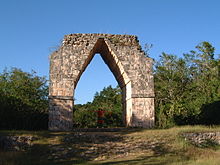Sacbe
Without a profound reliance on beasts of burden to transport goods, it remains partially unclear why the Maya decided to expend so much labor constructing these impressive roads.[3] Sacbeob constructed of these materials are especially important to contemporary studies of Maya sites, as they preserve well, making them capable of providing invaluable evidence to archaeologists.[6] Many sacbeob can be seen by modern visitors to Maya sites; a prominent one is at Chichen Itza, running from the main group around El Castillo to the Sacred Cenote.[7] Although much of the chronology and the time of origin is somewhat vague due to unclear historical records, there is a large possibility that the Sacbe is one of the oldest and longest traditions of the Maya.[citation needed] He is said to have been pleased to have discovered evidence of large, well-constructed sacbeob, reports of which he had previously believed to be exaggerations on the part of the Spanish conquistadores.[9] These preliminary reports included that of Diego López de Cogolludo, a chronicler from the 16th or 17th century, who noted that "there are remains of paved highways which traverse all this kingdom".In addition to their large spiritual significance, archeologists have long used the Sacbe to construct and understand the political and economic systems of the Maya.[13] Sacbeob have been found to be in close association with water sources at many sites, including the Sacred Cenote of Chichen Itza, which acts as a terminal point for a local sacbe.[13] At the Maya site of Cerén, located in El Salvador, studies of preserved plant material have revealed that sacbeob were used to transport goods amongst the agricultural fields in this area.[4] Some sacbeob that have been studied in the northwest Yucatán seem to have been constructed at times of conflict, rapid population growth and migration, and they have been interpreted by some as "permanent markers attesting to the relationships between dominant centers and satellite settlements," effectively a way of signifying and maintaining political boundaries.A number of sacbeob have been found around El Mirador and Tikal in the northern Petén Basin and around Copan in the southern Guatemalan Highlands, as well as at other sites.Rituals, including curing the sick, pilgrimage, procession, and dedication, involve movement as a generative source of power, capable of change and influence.Therefore, a study conducted by Sheets et al. concluded that construction of the Cerèn sacbe from these materials likely had religious and cosmological significance to the Maya.

Yucatec MayaMaya civilizationpre-ColumbianMesoamericastuccoroot termChichen ItzaEl CastilloSacred Cenotecorbel archesYaxunaMérida, YucatánIzamalCaribbean SeaPuerto MorelosCalakmulMayanistJohn Lloyd StephensMaya peopleYucatánprayerconquistadoresDiego López de Cogolludobeast of burdencenotesstelaeCenoteCaracolbarriosCerénEl SalvadorSan Salvador volcanoEl MiradorPetén BasinGuatemalan HighlandspilgrimageMilky Waycardinal directionsWorld Treeaxis munditephraProQuestNative American architectureStylesMesoamericanRío BecSan BartoloMayan RevivalMuiscaNeo-AndeanPuebloRevivalTerritorialTerritorial RevivalBuilding typesBarabaraCorn cribChickeeEarth lodgeGuachimontónLonghouseMalocaMesoamerican pyramidTriadicTwin-pyramidsPlank housePukaraQarmaqQuigglyQullqaRamadaShabonoSweat lodgeTemazcalWigwamStructuresBallcourtChultunE-GroupMoki stepsPlatform moundRope bridgeElementsAshlarCorbel archRoof combSascabSipapuTalud-tablero